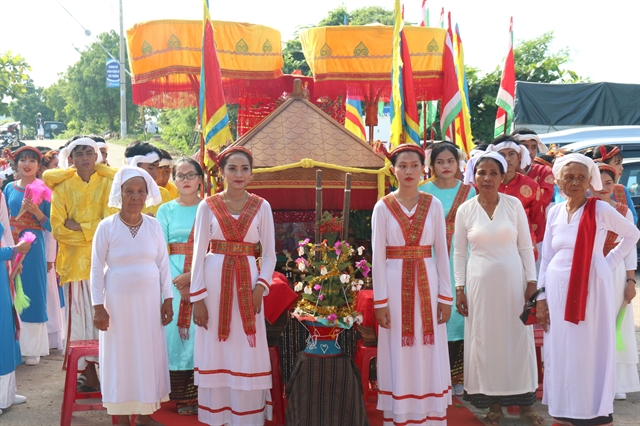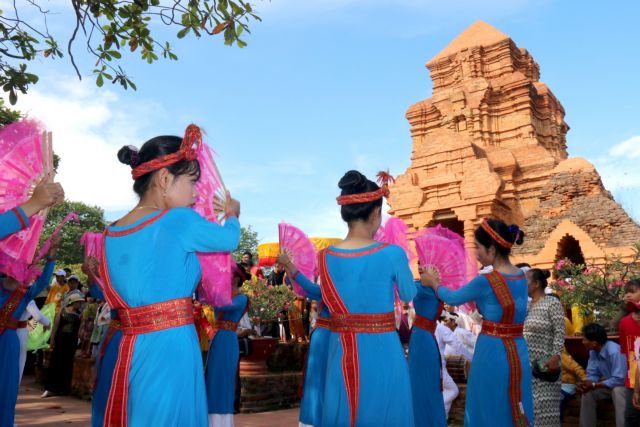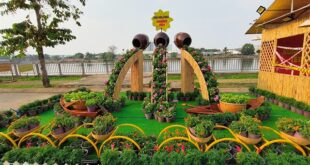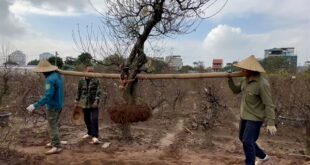
BÌNH THUẬN — Katê Festival, the largest traditional festival of the Chăm people in Bình Thuận Province, has been recognised by the Ministry of Culture, Sports and Tourism as an intangible cultural heritage.
The province’s People’s Committee is in charge of protecting, preserving and managing the heritage.
The Katê festival is celebrated annually for three days in the seventh lunar month by the Chăm, who follow the Balamon religion in the province.
It is an opportunity for them to show their gratitude to kings, mandarins and ancestors and pray for good harvests, health and prosperity.
The festival is held annually at Pô Sah Inư Chăm Towers in Phan Thiết City’s Phú Hài District with traditional rituals like offering costumes to Po Sah Inư Goddess, bathing Linga – Yoni statues, and performance of a ‘thanksgiving’ ceremony.
People and artists in traditional clothes will join and perform in ritual and cultural shows, folk dances and music performances with traditional instruments, and folk games.

The Katê is not only the most important festival of the Chăm in Bình Thuận but also contributes to promoting the culture and image of the province.
The Chăm community in Bình Thuận now has around 40,000 people mostly living in districts of Tuy Phong, Bắc Bình, Hàm Thuận Bắc and Tánh Linh.
Apart from Katê, the Chăm has other festivals to celebrate their religion and culture, such as Rijanưgar, Súc Dâng, and Tết Ramưwan.
For years, Bình Thuận has launched many plans to preserve and promote the festivals and the Chăm’s culture and heritage and improve their living standards.
Traditional gardening
The traditional Trà Quế Village vegetable gardening in Hội An, central province of Quảng Nam was also added in the same list of national intangible heritage.
The village – 3km away from the Old Quarter of Hội An – has preserved and practised the farming trade and lifestyle for centuries.
The village has become a favoured destination and rural farming site in Hội An and designed an organic farming zone for sustainable agro-tour development.
The 300-year-old village is already popular with tourists and travel agencies, offering farming experience tours, a day working with farmers and the chance to explore the rural lifestyles.
The gardening trade, which provides income for nearly 3,000 residents, will be a feature of the community-based tourism programme to reduce overcrowding in the Old Quarter of Hội An.

Various herbs such as basil, mint, coriander or Chinese parsley, citronella and other herbs from the village garden are used in local specialities such as Mỳ Quảng (Quảng Nam-style flat rice noodle) and Cao Lầu (local noodles) at restaurants and resorts in Hội An.
The village’s herbs were recognised as a brand name by the Intellectual Property Rights Agency of Việt Nam in 2009.
Travel agencies have offered farm experience tours at Trà Quế village and carpentry in Kim Bồng village, mat weaving in Bàn Thạch village, fishing in Trà Nhiêu village and rural lifestyle in Triêm Tây village in unique community-based tourism and rural craft tours.

Hội An – a UNESCO-recognised world heritage site – covers an area of 60sq.km, with 22.5sq.km of agriculture and forests and 11sq.km of lakes and canals.
The ancient town hosted 5.5 million tourists in 2019, but COVID-19 damaged the hospitality industry in 2020-21. — VnExpress News
- Reduce Hair Loss with PURA D’OR Gold Label Shampoo
- Castor Oil Has Made a “Huge” Difference With Hair and Brow Growth
- Excessive hair loss in men: Signs of illness that cannot be subjective
- Dịch Vụ SEO Website ở Los Angeles, CA: đưa trang web doanh nghiệp bạn lên top Google
- Nails Salon Sierra Madre
 VnExpress News The News Gateway of Vietnam
VnExpress News The News Gateway of Vietnam



